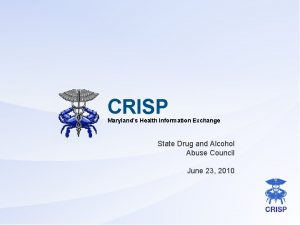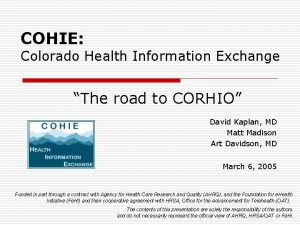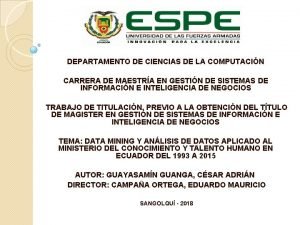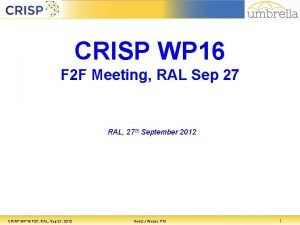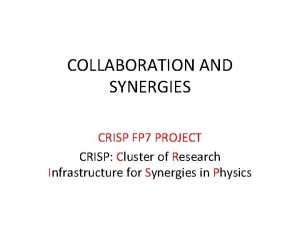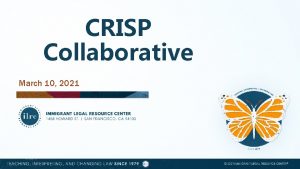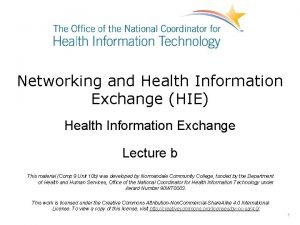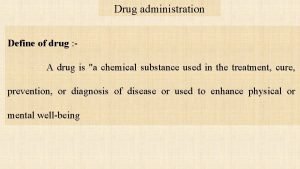CRISP Marylands Health Information Exchange State Drug and















- Slides: 15

CRISP Maryland’s Health Information Exchange State Drug and Alcohol Abuse Council June 23, 2010

What is CRISP? Ø CRISP (Chesapeake Regional Information System for our Patients) is Maryland’s statewide health information exchange (HIE) and Regional Extension Center (REC) – Health information exchange, or HIE, allows clinical information to move electronically among disparate health information systems. The goal of HIE is to deliver the right health information to the right place at the right time—providing safer, more timely, efficient, effective, equitable, patient-centered care. – Regional Extension Center (REC) is a program created by the ONC that is funded through the stimulus bill. RECs will offer technical, implementation, and educational assistance to facilitate providers’ adoption and meaningful use of electronic medical records (EMRs). 1

Mission Statement Our mission is to advance the health and wellness of Marylanders by deploying health information technology solutions adopted through cooperation and collaboration. We will enable the Maryland healthcare community to appropriately and securely share data, facilitate and integrate care, create efficiencies, and improve outcomes. 2

Guiding Principles Ø Begin with a manageable scope and remain incremental Ø Create opportunities to cooperate even while participants still compete in other ways Ø Affirm that competition and market-mechanisms spur innovation and improvement Ø Promote and enable consumers’ control over their own health information Ø Be flexible to support both distributed and data bank models Ø Use best practices and standards Ø Serve the entire Maryland healthcare community 3

CRISP History , in t d ar n o s g t e n o e n n S s EC M tio tati ni at a R e a ed ion n n s o t n u t y a la M t or rs sig nl en me P n p d u l e o S, ersa o S m n i e a d E l t p e e M v RI g ed ly HI fin ra to pl imp v M n C d s n o y i r s e s o e m d p U it i P ou wid es und or log ee wa lan or n n, in c m CC v M r c S m c o a I i f o b o 3 g t e s eg n at is ary in atio es chn 9. CR a pilo pr in su MH a r t r $ p p n ir ck I b r u e P M P fo z u a 0 M u he s E M IS of s ani es fo oc re t IS t to ro tory C C r 1 v e t R H i l R r G is p $ C J C ate C po fi org CR ve HC ISP ce ON P uctu t P H e S i t S M r s i I re m H ce IS rof R R astr C R C e o C r-p fr HC fr in fo M ant gr 4 4/10 3/10 8/09 7/09 5/09 2/09 6/07 6/06 Evolution of CRISP as Maryland’s HIE

Governance Structure 5

Funding Ø MHCC/HSCRC Award Ø Leverage all-payer system to award $10 M in seed funding for statewide HIE implementation Ø ONC HIE Grant Ø Roughly $9. 3 M in ARRA funding awarded to MHCC to support the CRISP statewide HIE effort Ø ONC Regional Extension Center Grant Ø Roughly $5. 5 M in ARRA funding awarded to CRISP to establish and operate the only REC in the state of Maryland 6

Infrastructure Design Standards-based, SOA, distributed infrastructure model with the ability to store data in local edge devices, shared edge devices, consumer driven health record banks, and/or hosted repositories. 7

Technology Approach Ø 5 -month, rigorous, transparent, and open technology procurement process 8 Checked references for top 5 vendors, along with review of KLAS report Performed vendor site visits for top 2 vendors Met with vendors and their clients at HIMSS conference Final decision vetted through Technology Committee, Board of Directors, and MHCC Issued detailed RFP and received 23 responses Performed several rounds of scoring evaluations for each Invited top 5 vendors to give presentations Group of clinicians evaluated clinical merits of top 5 vendors

Technology Approach Ø Contract recently signed with core infrastructure technology partner Axolotl Ø Privately held company located in Silicon Valley, California Ø Providing HIE solution since 1995 Ø Elysium exchange solutions are used by nearly 30, 000 physicians, 100, 000 healthcare professionals, over 200 hospitals, 20 RHIOs, 3 Statewide HIEs Ø Demonstrated ability to facilitate a rapid roll-out of the core infrastructure Ø Proven strategy for dealing with paper based physicians 9

Exchange Services Available at Launch Ø Patient Demographics Lookup Ø Lab Results, Radiology Reports, Transcribed Reports (Discharge Summaries, History, OP Notes, etc. ) Ø Clinicians can query the exchange to find recent results for a patient Ø Clinicians can push reports from their offices to a hospital or other clinician's office, and vice-versa Ø Clinicians can subscribe to a patient, and be alerted when a new result for their patient exists in the exchange Ø Referrals Ø Clinicians can refer patients by pushing patient demographics and their relevant medical information to another doctor Ø Secure Clinical Messaging Ø Clinicians can securely push messages and other medical data to other physicians in the exchange 10

Transport Approaches & Their Clinical Applications: Query Ø Primary care physician looks up historical health information on new patient 1. New patient arrives for appointment at primary care office. 2. Physician queries HIE for historical health information. 3. A list of documents and results relevant to that patient are presented to the physician. 4. Physician reviews available documents to gain an understanding of the patient’s health history. 11

Transport Approaches & Their Clinical Applications: Push Ø Doctor sends specific patient information to point of care 1. Patient is referred by PCP to Cardiologist. 2. PCP pushes patient health information through exchange to cardiologist. 3. Cardiologist’s office receives information & prepares it for visit. 4. Cardiologist can review results and notes prior to visit. 12

Transport Approaches & Their Clinical Applications: Subscribe & Alert Ø Doctor subscribes for information about specific patient, and is alerted when new data is in the exchange 1. Patient visits ER where a discharge summary is created. 2. Hospital publishes summary to HIE. 3. PCP is alerted of new discharge summary for his/her patient for review. 13 4. PCP notices harmful new prescription in summary, warns patient.

Roll-Out Strategy Ø We are pursuing an incremental roll-out strategy that focuses on geographic areas Ø CRISP considers a county’s technical readiness, willingness, impact, underserved population, and other factors unique to the area Ø Roll-out to hospitals will occur in parallel with ambulatory providers most relevant to each organization in terms of connectivity 14
 Crisp health information exchange
Crisp health information exchange Maryland health information exchange
Maryland health information exchange Exhausted drug
Exhausted drug Colorado health information exchange
Colorado health information exchange Difference between health education and counselling
Difference between health education and counselling Crisp-dm
Crisp-dm Fuzzy relation example
Fuzzy relation example Logika crisp
Logika crisp Crisp-dm stands for
Crisp-dm stands for Fuzzy logic
Fuzzy logic Phillip crisp
Phillip crisp Phillip crisp
Phillip crisp Crisp set vs fuzzy set
Crisp set vs fuzzy set Crisp set vs fuzzy set
Crisp set vs fuzzy set Crisp-dm
Crisp-dm Crisp wp
Crisp wp
